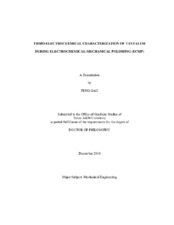| dc.description.abstract | Electrochemical Mechanical Polishing (ECMP) has become increasingly important due to the continuous decrease of the device size in integrated circuit (IC) fabrication. Tantalum (Ta) is a promising material as a substitute for copper in ICs. This dissertation studies the tribology and electrochemistry of Ta ECMP.
The present research uses experimental combined analysis approaches. A specially designed experimental setup assembling a tribometer and a potentiostat was used to carry out Ta ECMP. The friction force and electrochemical reactions were measured simultaneously. Using this setup, we found the factors which affected the frictional behaviors of Ta during ECMP. The technique of single frequency electrochemical impedance spectroscopy (EIS) was employed to investigate the material removal mechanisms in Ta ECMP. The results presented the competing mechanisms of removal and formation of a surface oxide layer of Ta.
In order to further the investigation in a nanoscale, the atomic force microscope (AFM) was used to measure the material removal rate. The Preston equation for the Ta ECMP was established. A new methodology was developed to study the oxidation state and process of Ta during ECMP. Through comparing the material removal rate measured by using the AFM and the calculated one via the Faraday’s law, the distribution of the Ta suboxides and pentoxide, as well as the oxidation process, was revealed. The oxidation process was strongly dependent of the applied anodic potential, thickness of the oxide layer, mechanical forces, and surface orientation. A polymer environmental cell was designed and produced. Using this cell and AFM, it was found that the material removal in the nanometer scale was a function of the surface orientations. This research is beneficial for optimization of the Ta ECMP process.
This dissertation includes six chapters. After Introduction and Motivation and Objectives, the material, setup, and testing conditions are discussed in Chapter III. Chapter IV discusses the tribology and material removal mechanisms in Ta ECMP, while Chapter V the oxidation of Ta during ECMP, followed by Conclusions and Future Work. | en |


